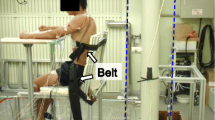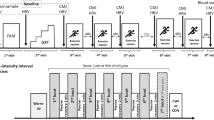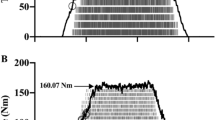Abstract
The consequences of a prolonged total body immersion in cold water on the muscle function have not been documented yet, and they are the object of this French Navy research program. Ten elite divers were totally immerged and stayed immobile during 6 h in cold (18 and 10°C) water. We measured the maximal voluntary leg extension (maximal voluntary contraction, MVC) and evoked compound muscle potential (M wave) in vastus lateralis and soleus muscles at rest, after a submaximal (60% MVC) isometric extension allowing the measurement of the endurance time (Tlim). The power spectrum of surface electromyograms (EMG) was computed during 60% MVCs. MVCs and 60% MVC maneuvers were repeated four times during the immersion. Data were compared with those obtained in a control group studied in dry air condition during a 6-h session. Total body cooling did not affect MVC nor Tlim. The M wave duration increased in the coolest muscle (soleus), but only at 10°C at rest. There were no further fatigue-induced M wave alterations in both muscles. During 60% the MVCs, a time-dependant increase in the leftward shift of the EMG spectrum occurred at the two temperatures. These EMG changes were absent in the control group of subjects studied in dry air. The plasma lactate concentration was elevated throughout the 18 and mostly the 10°C immersion conditions. Throughout the 18°C immersion study, the resting potassium level did not significantly vary, whereas at 10°C, a significant potassium increase occurred soon and persisted throughout the study. Thus, total body immersion in cold water did not affect the global contractile properties of leg muscles during static efforts but elicited significant alterations in electromyographic events which may be related to the variations of interstitial fluid composition.








Similar content being viewed by others
References
Adriaensen H, Gybels J, Handwerker HO, Van Hees J (1983) Response properties of thin myelinated (A-delta) fibers in human skin nerves. J Neurophysiol 49:111–122
Arbogast S, Vassilakopoulos T, Darques JL, Duvauchelle JB, Jammes Y (2000) Influence of oxygen supply on activation of group IV muscle afferents after low-frequency muscle stimulation. Muscle Nerve 23:1187–1193
Badier M, Guillot C, Lagier-Tessonnier F, Jammes Y (1994) EMG changes in respiratory and skeletal muscles during isometric contraction under normoxic, hypoxemic, or ischemic conditions. Muscle Nerve 17:500–508
Bendahan D, Badier M, Jammes Y, Confort-Gouny S, Salvan AM, Guillot C, Cozzone PJ (1998) Metabolic and myoelectrical effects of acute hypoxaemia during isometric contraction of forearm muscles in humans: a combined 31P-magnetic resonance spectroscopy-surface electromyogram (MRS-SEMG) study. Clin Sci (Lond) 94:279–286
Bertram MF, Nishida T, Minieka MM, Janssen I, Levy CE (1995) Effects of temperature on motor unit action potentials during isometric contraction. Muscle Nerve 18:1443–1446
Bigland-Ritchie B, Thomas CK, Rice CL, Howarth JV, Woods JJ (1992) Muscle temperature, contractile speed, and motoneuron firing rates during human voluntary contractions. J Appl Physiol 73:2457–2461
Bigland-Ritchie BR, Dawson NJ, Johansson RS, Lippold OC (1986) Reflex origin for the slowing of motoneurone firing rates in fatigue of human voluntary contractions. J Physiol 379:451–459
Blomstrand E, Essen-Gustavsson B (1987) Influence of reduced muscle temperature on metabolism in type I and type II human muscle fibres during intensive exercise. Acta Physiol Scand 131:569–574
Bolton CF, Sawa GM, Carter K (1981) The effects of temperature on human compound action potentials. J Neurol Neurosurg Psychiatry 44:407–413
Buchthal F, Pinell P, Rosenfalck P (1954) Action potential parameters in normal human muscle and their physiological determinants. Acta Physiol Scand 32:219–229
Campero M, Serra J, Ochoa JL (1996) C-polymodal nociceptors activated by noxious low temperature in human skin. J Physiol 497:565–572
Caquelard F, Burnet H, Tagliarini F, Cauchy E, Richalet JP, Jammes Y (2000) Effects of prolonged hypobaric hypoxia on human skeletal muscle function and electromyographic events. Clin Sci (Lond) 98:329–337
Darques JL, Jammes Y (1997) Fatigue-induced changes in group IV muscle afferent activity: differences between high- and low-frequency electrically induced fatigues. Brain Res 750:147–154
Davies CT, Mecrow IK, White MJ (1982) Contractile properties of the human triceps surae with some observations on the effects of temperature and exercise. Eur J Appl Physiol Occup Physiol 49:255–269
Decherchi P, Darques JL, Jammes Y (1998) Modifications of afferent activities from Tibialis anterior muscle in rat by tendon vibrations, increase of interstitial potassium or lactate concentration and electrically-induced fatigue. J Peripher Nerv Syst 3:267–276
Dill DB, Costill DL (1974) Calculation of percentage changes in volumes of blood, plasma, and red cells in dehydration. J Appl Physiol 37:247–248
Dousset E, Decherchi P, Grelot L, Jammes Y (2001) Effects of chronic hypoxemia on the afferent nerve activities from skeletal muscle. Am J Respir Crit Care Med 164:1476–1480
Dousset E, Steinberg JG, Balon N, Jammes Y (2001) Effects of acute hypoxemia on force and surface EMG during sustained handgrip. Muscle Nerve 24:364–371
Edwards RH, Harris RC, Hultman E, Kaijser L, Koh D, Nordesjo LO (1992) Effect of temperature on muscle energy metabolism and endurance during successive isometric contractions, sustained to fatigue, of the quadriceps muscle in man. J Physiol 220:335–352
Enoka RM, Stuart DG (1992) Neurobiology of muscle fatigue. J Appl Physiol 72:1631–1648
Faucher M, Steinberg JG, Barbier D, Hug F, Jammes Y (2004) Influence of chronic hypoxemia on peripheral muscle function and oxidative stress in humans. Clin Physiol Funct Imaging 24:75–84
Gandevia SC (2001) Spinal and supraspinal factors in human muscle fatigue. Physiol Rev 81:1725–1789
Garland SJ (1991) Role of small diameter afferents in reflex inhibition during human muscle fatigue. J Physiol 435:547–558
Gerilovsky L, Radicheva N, Gydikov A (1988) Dependence between intra- and extracellular action potentials of isolated frog muscle fibres at different temperatures. Acta Physiol Pharmacol Bulg 14:12–19
Graven-Nielsen T, Arendt-Nielsen L, Mense S (2002) Thermosensitivity of muscle: high-intensity thermal stimulation of muscle tissue induces muscle pain in humans. J Physiol 540:647–656
Holewijn M, Heus R (1992) Effects of temperature on electromyogram and muscle function. Eur J Appl Physiol Occup Physiol 65:541–545
Jammes Y, Balzamo E (1992) Changes in afferent and efferent phrenic activities with electrically induced diaphragmatic fatigue. J Appl Physiol 73:894–902
Johnson MA, Polgar J, Weightman D, Appleton D (1973) Data on the distribution of fibre types in thirty-six human muscles. An autopsy study. J Neurol Sci 18:111–129
Kadefors R, Kaiser E, Petersen I (1968) Dynamic spectrum analysis of myo-potentials and with special reference to muscle fatigue. Electromyography 8:39–74
Kranz H, Williams AM, Cassell J, Caddy DJ, Silberstein RB (1983) Factors determining the frequency content of the electromyogram. J Appl Physiol 55:392–399
Marey E (1868) Du mouvement dans les fonctions de la vie. Germer Baillère, Paris
Marsden CD, Meadows JC, Merton PA (1983) “Muscular wisdom” that minimizes fatigue during prolonged effort in man: peak rates of motoneuron discharge and slowing of discharge during fatigue. Adv Neurol 39:169–211
Meigal AY, Oksa J, Hohtola E, Lupandin YV, Rintamaki H (1998) Influence of cold shivering on fine motor control in the upper limb. Acta Physiol Scand 163:41–47
Meigal AY, Oksa J, Gerasimova LI, Hohtola E, Lupandin YV, Rintamaki H (2003) Force control of isometric elbow flexion with visual feedback in cold with and without shivering. Aviat Space Environ Med 74:816–821
Mense S (1996) Group III and IV receptors in skeletal muscle: are they specific or polymodal? Prog Brain Res 113:83–100
Oksa J, Rintamaki H, Rissanen S (1997) Muscle performance and electromyogram activity of the lower leg muscles with different levels of cold exposure. Eur J Appl Physiol Occup Physiol 75:484–490
Schieppati M, Nardone A (1997) Medium-latency stretch reflexes of foot and leg muscles analysed by cooling the lower limb in standing humans. J Physiol 503:691–698
Shiojiri T, Shibasaki M, Aoki K, Kondo N, Koga S (1997) Effects of reduced muscle temperature on the oxygen uptake kinetics at the start of exercise. Acta Physiol Scand 159:327–333
Shmulewitsch J (1868) Zur muskelphysiologie und physik. Med Jahrb 15:3–36
Sjogaard G (1990) Exercise-induced muscle fatigue: the significance of potassium. Acta Physiol Scand Suppl 593:1–63
Stulen FB, DeLuca CJ (1981) Frequency parameters of the myoelectric signal as a measure of muscle conduction velocity. IEEE Trans Biomed Eng 28:515–523
Woods JJ, Furbush F, Bigland-Ritchie B (1987) Evidence for a fatigue-induced reflex inhibition of motoneuron firing rates. J Neurophysiol 58:125–137
Author information
Authors and Affiliations
Corresponding author
Rights and permissions
About this article
Cite this article
Coulange, M., Hug, F., Kipson, N. et al. Consequences of prolonged total body immersion in cold water on muscle performance and EMG activity. Pflugers Arch - Eur J Physiol 452, 91–101 (2006). https://doi.org/10.1007/s00424-005-0013-x
Received:
Revised:
Accepted:
Published:
Issue Date:
DOI: https://doi.org/10.1007/s00424-005-0013-x




